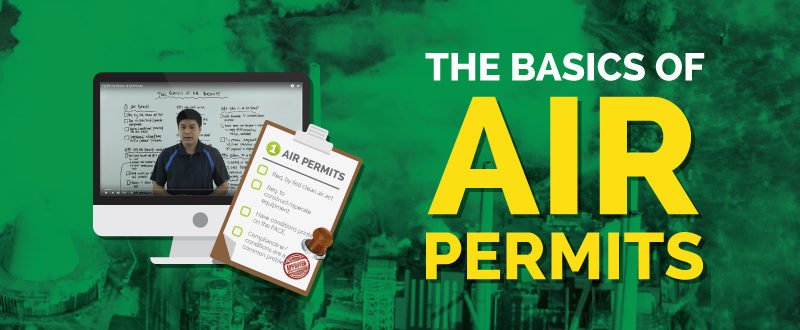
The following text is an abridged and edited transcript of the above video.
Air permits are required by the federal Clean Air Act to construct and operate a piece of factory equipment if it needs an air permit. Permits have conditions printed on their faces, and you must comply with those conditions at all times.
Not complying with permit conditions is a common problem at regulated facilities. In fact, the South Coast Air Quality Management District (SCAQMD) has issued countless violations due to such compliance issues, often because facilities have trouble complying with the conditions.
Why Are Air Permits Needed? [02:18]
The requirement to have air permits began with the 1977 amendments to the federal Clean Air Act and to a program called New Source Review (NSR), which was designed to ensure that the addition of new sources of air pollution do not further degrade air quality. This is done by verifying that new construction uses technology that makes emissions as clean as possible.
Air permits achieve these goals in the following ways:
- NSR requires that new sources of air pollution not result in an increase of emissions by requiring new equipment to have a known net increase of emissions. The operator, owner-operator, or individual applying for the air permit is required to secure emission reduction credits (ERCs) to offset the amount their equipment emits. These credits are generated by an emission decrease from decommissioning old equipment at the facility or from somewhere else within the South Coast district.
- NSR ensures that construction uses technologies that make emissions as clean as possible by requiring the use of Best Available Control Technology (BACT). SCAQMD Regulation XIII deals with NSR and quantifying the emission increase, and showing that it’s offset somewhere else is a requirement, as is ensuring that the equipment needs or meets the requirements for BACT. All of those requirements need to be satisfied when doing a rule analysis for Regulation XIII.
The SCAQMD will issue the permit if the requirements of New Source Review are met. That’s in addition to ensuring that the operator has demonstrated, to the satisfaction of the permit engineer, that this piece of equipment can operate in compliance with all SCAQMD rules and regulations.
Rules 201, 219 & 222 [06:11]
According to Rule 201, any owner or operator of a piece of equipment that emits, has the potential to emit, or controls air contaminants is required to have a permit from the SCAQMD. The rule also states that any piece of equipment that emits, controls, or has the potential to emit or control air contaminants needs a permit.
Determining when a piece of equipment needs a permit is important. A lot of people have problems with this. To properly determine whether or not a piece of equipment needs a permit, you have to review three rules: 201, 219, and 222. At Envera, we call these the “trio of permit-applicability rules.” For more info, read our article on how to determine if your equipment needs an SCAQMD air permit.
What Is an Air Permit? [12:10]
An air permit is a legal document that authorizes the owner or operator to construct and/or operate a piece of equipment according to the federal Clean Air Act.
When a facility receives a permit for a piece of equipment, that permit means that the equipment is expected to comply with all of the rules and regulations of the SCAQMD, as well as state air-quality regulations and federal air-quality regulations. Included with that is NSR, and that’s demonstrated by compliance with Regulation XIII.
The SCAQMD prints conditions on the face of a permit. As a holder of a permit, you must comply with those conditions at all times — even if there’s a typo. So, if your permit condition says that operating time is two hours rather than 200 hours, you’re still responsible for complying with that condition. Typos are just one of the many common problems associated with air permits, so be sure to review all conditions before accepting the document — or your problems (and fees) could get even bigger.
Where Do You Apply for an Air Permit? [15:01]
Check this page to see if your facility falls under the jurisdiction of the SCAQMD. Other states have their own agencies whose regulations your facility must comply with.
Applying for an SCAQMD permit is simple — in theory. Here’s the five-step process:
- Determine the applicability.
- Prepare an application. Generally, an application will have three components — forms, fees, and a detailed engineering evaluation.
- Submit the application to the SCAQMD.
- Answer any questions the engineer may have related to the documents or the permit application you submitted.
- Receive your permit in the mail.
It seems like a simple process. Where people tend to go wrong is by preparing an incomplete application, which usually results in a lot of back-and-forth with the SCAQMD, as well as additional analyses. If you’re worried you won’t be able to sufficiently complete your application, consider hiring a Certified Permitting Professional. The cost of hiring a CPP is often offset by the time and additional analyses saved.
Still need help? Contact us and we’ll guide you through the SCAQMD permitting process.